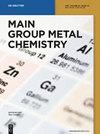Efficient photocatalytic degradation of organic dye from aqueous solutions over zinc oxide incorporated nanocellulose under visible light irradiation
IF 1.2
3区 化学
Q3 CHEMISTRY, INORGANIC & NUCLEAR
引用次数: 16
Abstract
Abstract Increased growth of textile industries leads to the tremendous accumulation of dyes on water and surrounding environments. This terrific increase of dyes is the major cause of water pollution which in turn adversely affects the aquatic lives and the balance of our ecosystem. Purpose of the present study is to report the synthesis and characterization of a composite namely zinc oxide incorporated nanocellulose (ZnO/NC) for effective degradation of an anionic dye, Congo red. Fourier transform infrared spectroscopy (FTIR), X-ray diffraction (XRD), Brunaeur, Emmett and Teller (BET) surface area analysis and scanning electron microscopy (SEM) studies have helped to characterize the composite. The optical properties of the samples were studied by UV-Visible spectroscopy. Feasibility of the photocatalyst in the degradation of Congo red was tested. Experimental conditions such as time of contact, concentration of the dye solution, catalyst dosage, pH were altered to find out the optimum conditions of degradation. The optimum pH was found to be 5.5 and dosage of ZnO/NC was optimized as 0.075 g for a dye concentration of 20 ppm. Equilibrium was attained at 120 min. The studies reveal that the photocatalyst ZnO/NC is efficient for the photodegradation of Congo red. Photodegradation was due to electron hole interaction between metal oxides and nanocellulose.可见光照射下氧化锌纳米纤维素对水溶液中有机染料的有效光催化降解
摘要纺织工业的增长导致染料在水和周围环境中的大量积累。染料的急剧增加是水污染的主要原因,而水污染反过来又对水生生物和生态系统的平衡产生了不利影响。本研究的目的是报道一种复合材料的合成和表征,即掺入氧化锌的纳米纤维素(ZnO/NC),用于有效降解阴离子染料刚果红。傅里叶变换红外光谱(FTIR)、X射线衍射(XRD)、Brunaeur,Emmett和Teller(BET)表面积分析和扫描电子显微镜(SEM)研究有助于表征复合材料。用紫外可见光谱法研究了样品的光学性质。测试了光催化剂降解刚果红的可行性。改变接触时间、染料溶液浓度、催化剂用量、pH等实验条件,找出降解的最佳条件。发现最佳pH为5.5,并且对于20ppm的染料浓度,ZnO/NC的剂量被优化为0.075g。在120分钟时达到平衡。研究表明,光催化剂ZnO/NC对刚果红的光降解是有效的。光降解是由于金属氧化物和纳米纤维素之间的电子-空穴相互作用。
本文章由计算机程序翻译,如有差异,请以英文原文为准。
求助全文
约1分钟内获得全文
求助全文
来源期刊

Main Group Metal Chemistry
CHEMISTRY, INORGANIC & NUCLEAR-CHEMISTRY, ORGANIC
CiteScore
4.10
自引率
27.80%
发文量
21
审稿时长
4 weeks
期刊介绍:
This journal is committed to the publication of short communications, original research, and review articles within the field of main group metal and semi-metal chemistry, Main Group Metal Chemistry is an open-access, peer-reviewed journal that publishes in ongoing way. Papers addressing the theoretical, spectroscopic, mechanistic and synthetic aspects of inorganic, coordination and organometallic main group metal and semi-metal compounds, including zinc, cadmium and mercury are welcome. The journal also publishes studies relating to environmental aspects of these metals, their toxicology, release pathways and fate. Articles on the applications of main group metal chemistry, including in the fields of polymer chemistry, agriculture, electronics and catalysis, are also accepted.
 求助内容:
求助内容: 应助结果提醒方式:
应助结果提醒方式:


